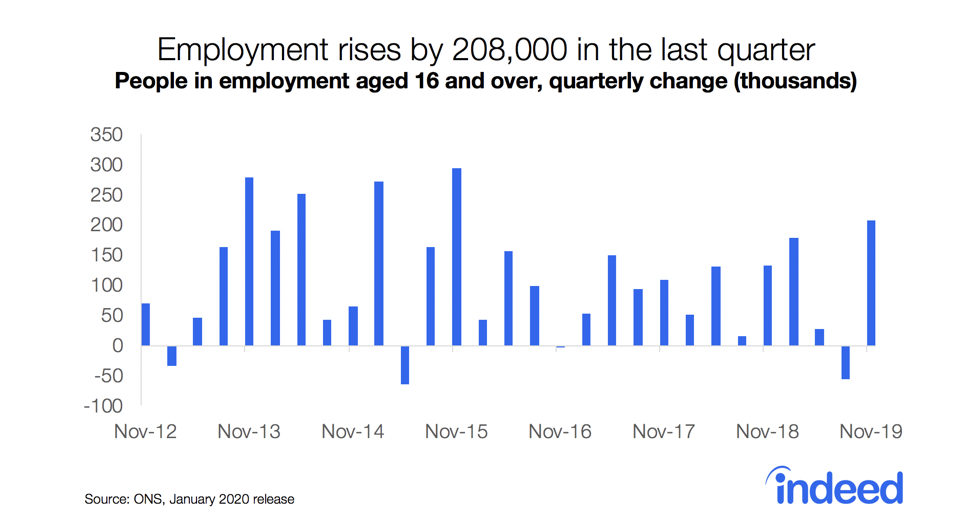We regularly update this report to track the pandemic’s effects on the labour market. Our methodology changed at the start of 2021 — see note at end of post.
Job posting recovery continues. On 23 April 2021 job postings on Indeed – a timely measure of hiring activity in the UK – were just 10% below their level on 1 February 2020, our pre-pandemic baseline, after adjusting for seasonal variations. That is an improvement of 6 percentage points (ppts) since our last blog post two weeks ago.
Since the government’s reopening roadmap was announced on 22 February this year, there has been a 27 percentage-point improvement in job postings relative to the pre-pandemic baseline – a substantial recovery.
UK job postings are catching up to other European countries
Job postings in the UK are catching up to other large European countries in terms of recovery relative to the pre-pandemic level. While the UK suffered one of the biggest hits to GDP and one of the biggest hits to job postings among advanced economies when the pandemic started, recent recovery in postings has been impressive. We will continue to monitor this trend as more sectors and businesses reopen.
Reopening sectors continue to see growth
There have been broad-based improvements in job postings over the last two weeks as retailers, hospitality venues and other businesses continued to reopen across the UK and prepared for further easing of restrictions in the coming weeks. The biggest gains have been in food preparation & service occupations (+18 ppts), followed by driving (+14 ppts), retail (+13 ppts) and cleaning & sanitation (+12 ppts).
Construction (+12 ppts), loading & stocking (+10 ppts) and production & manufacturing (+10 ppts) have also seen gains in the total volume of job postings. Our recent research with the Centre for Cities showed that cities with production and distribution hubs have experienced the fastest recovery in job postings this spring.
Job postings in many occupations are now above their pre-pandemic level. This includes construction, loading & stocking, driving, production & manufacturing, cleaning & sanitation, and physicians & surgeons.
The North East and Wales have cleared the pre-pandemic level of job postings
All regions have seen improvements in job postings over the last two weeks. Postings in the North East and in Wales have exceeded their pre-pandemic level for the first time, by 4 and 1 percentage points, respectively.
Northern Ireland, the South East and London continue to lag the rest of the UK in job posting recovery. Restrictions in Northern Ireland are being eased on a slightly more cautious timescale than the rest of the UK, with non-essential indoor retail and outdoor hospitality venues only allowed to reopen at the end of this week. The South is generally lagging the Midlands and the North of England due to a lower concentration of postings in the fastest-growing occupations.
We will continue to update these trends regularly as the situation evolves. We also host the data behind the postings trends plots on Github as downloadable CSV files. Typically, the site will be updated with the latest data one day after the respective Hiring Lab tracker is published.
Methodology
All figures in this blog post are the percentage change in seasonally-adjusted job postings since February 1, 2020, using a seven-day trailing average. February 1, 2020, is our pre-pandemic baseline. We seasonally adjust each series based on historical patterns in 2017, 2018, and 2019. Each series, including the national trend, occupational sectors, and sub-national geographies, is seasonally adjusted separately. We adopted this new methodology in January 2021 and now use it to report all historical data. Historical numbers have been revised and may differ significantly from originally reported values.
The number of job postings on Indeed.com, whether related to paid or unpaid job solicitations, is not indicative of potential revenue or earnings of Indeed, which comprises a significant percentage of the HR Technology segment of its parent company, Recruit Holdings Co., Ltd. Job posting numbers are provided for information purposes only and should not be viewed as an indicator of performance of Indeed or Recruit. Please refer to the Recruit Holdings investor relations website and regulatory filings in Japan for more detailed information on revenue generation by Recruit’s HR Technology segment.






